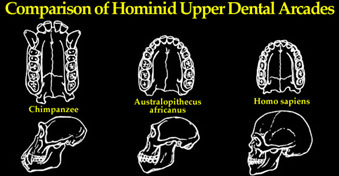The Physical Characteristics of Humans
- Page 14 -
Human Teeth and Jaws
 Humans are equipped with the basic mammalian set of teeth. We have two sets, in fact, the first of which erupt while we are still juveniles (our baby teeth). There are 32 adult or permanent teeth. They show the typical mammalian specialization in function from the front to back of the mouth. The front teeth, or incisors, are adapted for cutting or tearing off pieces of food, and the back teeth, the molars, are adapted for grinding food materials. The intermediate teeth are intermediate in function and design.
Humans are equipped with the basic mammalian set of teeth. We have two sets, in fact, the first of which erupt while we are still juveniles (our baby teeth). There are 32 adult or permanent teeth. They show the typical mammalian specialization in function from the front to back of the mouth. The front teeth, or incisors, are adapted for cutting or tearing off pieces of food, and the back teeth, the molars, are adapted for grinding food materials. The intermediate teeth are intermediate in function and design.
Human teeth are generally smaller and less specialized than those of apes and have thinner enamel. The most striking difference between human teeth and ape teeth is the absence in humans of huge canines. Since large canines are used in many primate species for social display and competition for dominance, the loss of distinctive canines in hominids is sometimes taken as a sign that less competitive and more cooperative forms of social behavior emerged in very early times. There is little evidence either to support or refute such contentions.
One "signature" in the anatomy of our species which is very useful to scientists hunting for fossil remains is our molars, which have five points or crowns on the grinding surface, while ape molars have only four.
Our jaws are relatively small and unimpressive compared to those of apes, as are our jaw muscles. This development toward smaller jaws coincides in the fossil record with evidence of the use of fire, and raises interesting questions about the substitution of cultural techniques for some of the basic biological functions, such as chewing. Our ancestors dealt with tough materials by cooking, cutting, or pounding them to make them ingestible and digestible.
 Humans are equipped with the basic mammalian set of teeth. We have two sets, in fact, the first of which erupt while we are still juveniles (our baby teeth). There are 32 adult or permanent teeth. They show the typical mammalian specialization in function from the front to back of the mouth. The front teeth, or incisors, are adapted for cutting or tearing off pieces of food, and the back teeth, the molars, are adapted for grinding food materials. The intermediate teeth are intermediate in function and design.
Humans are equipped with the basic mammalian set of teeth. We have two sets, in fact, the first of which erupt while we are still juveniles (our baby teeth). There are 32 adult or permanent teeth. They show the typical mammalian specialization in function from the front to back of the mouth. The front teeth, or incisors, are adapted for cutting or tearing off pieces of food, and the back teeth, the molars, are adapted for grinding food materials. The intermediate teeth are intermediate in function and design. 
